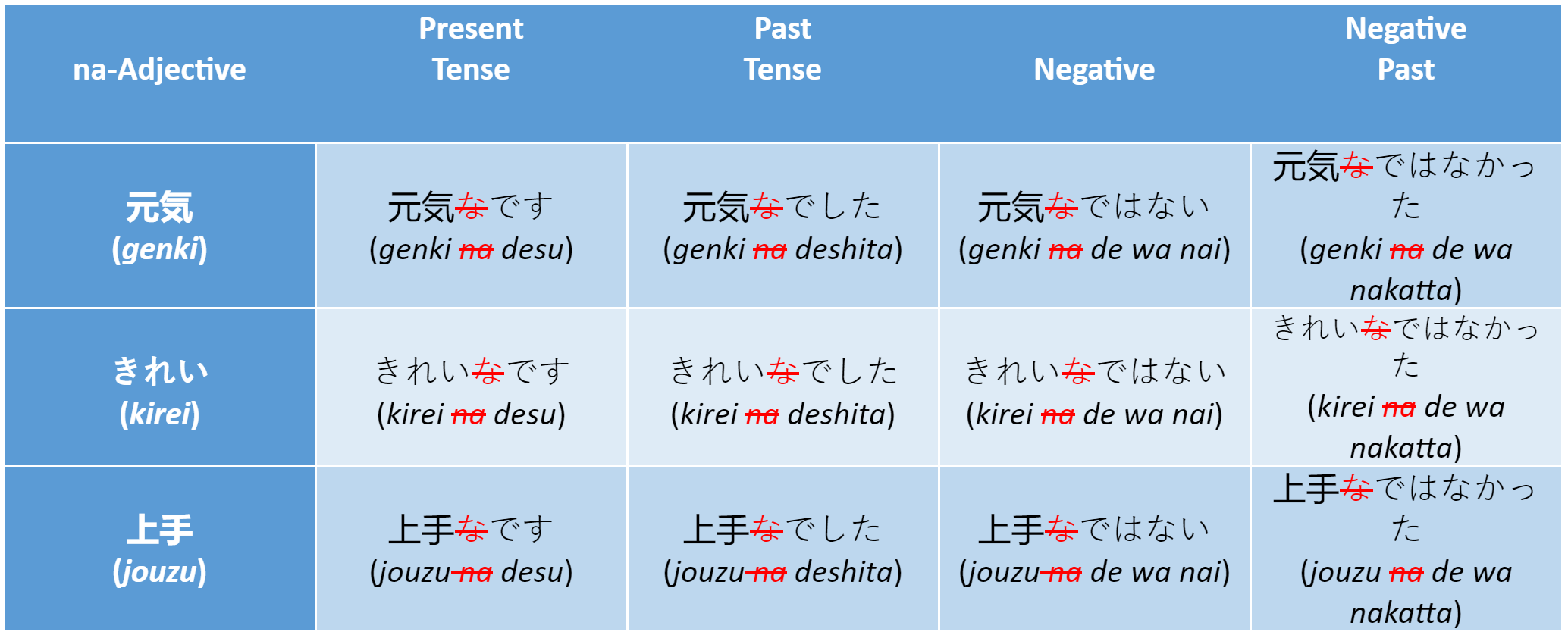
Adjectives are essential building blocks for learning Japanese. How else are you going to explain how delicious that fatty salmon sushi was? The Japanese language has two types of adjectives: い-adjectives and な-adjectives. Both must be conjugated like verbs. In this article, we’re going to introduce 10 fail-proof Japanese adjectives that you’ll be certain to use daily. We’ll then use those adjectives as examples to explain the do’s and don’t’s for this tricky bit of Japanese grammar.
The Two Types of Japanese Adjectives…and Their Exception
Before we jump into our adjective list, it’s important to understand what defines an i-adjective, a na-adjective, or a nominal adjective.
As the name suggests, i-adjectives, or 形容詞 (keiyoushi) always end with the single hiragana character い (i). That last i character is usually removed when the adjective is conjugated.
On the other hand, na-adjectives, or 形容動詞 (keiyoudoushi) may end with any sound or character. Typically, these adjectives are composed fully of kanji and have no overhanging hiragana characters. They’re called “na-adjectives” because a な (na) is added to the adjectives when they come before a noun. When the adjectives are conjugated, however, that na is dropped.
There’s also one glaring exception to the categorization of Japanese adjectives. よい (Yoi) or “good” has its own rules, which we’ll cover more at the end of the article.
10 Japanese Adjectives for Daily Use
Here are our 10 favorite adjectives that native speakers use most in their daily lives. We’ll put each adjective in its category and make an example sentence or two for you to practice with.
美味しい (oishii) – delicious
Oishii is an i-adjective that you’ll likely use a lot if you visit a Japanese restaurant.
Examples:
- この寿司は美味しいです! Kono sushi wa oishii desu! This sushi is delicious!
- こんなに美味しいケーキを食べるのは初めてです. Konna ni oishii keeki o taberu no wa hajimete desu. It’s the first time I’ve had a cake this delicious.
元気 (genki) – fine, active, healthy
Genki is a na-adjective. Japanese people always use genki to ask how someone is doing. This adjective can also be used to describe someone who’s particularly active or healthy. On the opposite side of things, the negative form of genki is used when one is feeling unwell.
Examples:
- こんにちは! 元気ですか? Konnichiwa! Genki desu ka? Hello! How are you?
- 元気なワンちゃん飼っていますね. Genki na wan-chan katteimasu ne. You have a very active puppy, don’t you?
- 今日はそんなに元気ではないので、休みします. Kyou wa sonna ni genki de wa nai no de, yasumi shimasu. I’m not feeling so well today, so I’m going to take the day off.
暑い/熱い (atsui) – hot, passionate
暑い (Atsui) means “hot”, and is used yearly in the humid summers of Japan. The word atsui can also be used to describe hot things such as food, or even the fiery passion of a hard worker. In these latter cases, however, the kanji while the pronunciation remains the same: 熱い (atsui). Both variations are i-adjectives. 寒い (samui), which means “cold”, is atsui’s opposite and is also an i-adjective.
Examples:
- 今日も暑い日ですね! Kyou mo atsui hi desu ne! Today’s another scorcher!
- そのたこ焼きは熱いですので、気を付けてください. Sono takoyaki wa atsui desu no de, ki o tsukete kudasai. That takoyaki is hot, so please be careful.
すごい (sugoi) – amazing, extreme, very
Sugoi is a very popular i-adjective in Japanese. It’s most often used to show surprise or amazement, and can also be added as a modifier to other adjectives.
Examples:
- すごい! ハンバーガーを三つ食べた! Sugoi! Hanbaagaa wo mittsu tabeta! Amazing! You ate three whole hamburgers!
- あの猫はすごくかわいいですね. Ano neko wa sugoku kawaii desu ne. That cat is very cute, isn’t she?
上手 (jouzu) – skilled
Jouzu is a na-adjective, and means “skilled” in Japanese. Its antonym, 下手 (heta) is also a na-adjective and follows the same conjugation rules in a sentence.
Examples:
- 日本語は上手ですね. Nihongo wa jouzu desu ne. Your Japanese is very good.
- 彼は上手な漫画家です. Kare wa jouzu na mangaka desu. He’s a skilled manga artist.
強い (tsuyoi) – strong, powerful
Tsuyoi is an i-adjective, as is its opposite 弱い (yowai), or “weak”.
Examples:
- 彼は強い人ですね. Kare wa tsuyoi hito desu ne. He’s a really strong person.
- この紐をもう少し強く引っ張ってください. Kono himo o mou sukoshi tsuyoku hippatte kudasai. Please pull this string a bit more strongly.
かわいい (kawaii) – cute, adorable
Kawaii is an i-adjective and is widely used in Japanese and even Western pop culture. While the literal translation is “cute,” kawaii is also often used to describe something pretty or attractive. When used in this sense, it holds a feminine connotation.
Examples:
- あのドレスかわいいね! Ano doresu kawaii ne! That dress is pretty!
- かわいい子猫を拾った. Kawaii koneko o hirotta. I rescued a cute kitten.
危ない (abunai) – dangerous
One i-adjective you want to memorize for safety’s sake is abunai, or “dangerous.” You’ll see this word on quite a few signs in Japan, so be sure to keep an eye out for it. While abunai is an i-adjective, its synonym 危険 (kiken) is a na-adjective. Both mean “dangerous.”
Examples:
- 危ない行動をやめましょう. Abunai koudou o yamemashou. Let’s avoid doing dangerous things.
きれい (kirei) – pretty, beautiful
While the adjective kirei technically ends with い (i), it’s actually a na-adjective. This may seem like an exception to the rule, but kirei is actually composed of two kanji (綺麗), and doesn’t have an extra い character at its end. Kirei is often written only in hiragana, as its kanji is quite difficult. It means “pretty” or “beautiful.”
Examples:
- 妻は綺麗な人ですね. Tsuma wa kirei na hito desu ne. Your wife is beautiful.
- 先ほど, 綺麗な花を見かけた. Saki hodo, kirei na hana o mikaketa. I saw a pretty flower just now.
楽しい (tanoshii) – fun, enjoyable, exciting
The last word on our list is another i-adjective. Tanoshii means “fun” or “exciting.” Its opposite, つまらない (tsumaranai), or “boring” is also an i-adjective.
Examples:
- 昨日のパーティーは楽しかったです. Kinou no paatii wa tanoshikatta desu. Yesterday’s party was fun.
- 楽しい時間を過ごしてください. Tanoshii jikan o sugoshite kudasai. Please have a fun time.
Conjugating i-Adjectives and na-Adjectives in Japanese
Japanese adjectives follow the same conjugation pattern as Japanese verbs do: the adjective’s conjugation depends on the tense, as well as whether the speaker is using a positive or negative connotation.
Conjugating Japanese adjectives still involves levels of politeness, as any Japanese grammar might. You can check out our post on Japanese honorifics to learn more.
i-Adjectives

When placed before the noun it’s describing, an i-adjective requires no additional suffix or conjugation.
あのかわいいコップを買ってください. Ano kawaii koppu o katte kudasai. Please buy that cute cup.
If the i-adjective comes after the noun it’s describing, you’ll have to conjugate it. In the present tense, however, the adjective will remain the same.
あのコップはかわいいです. Ano koppu wa kawaii desu. That cup is cute.
For the past and negative tenses, you’ll have to remove the final い (i) from the word. The present negative tense must be conjugated with -くない (-kunai), and the past tense with -かった (-katta). The negative past combines both suffixes to become -くなかった (-kunakatta).
- 今日の天気はそんなに暑くない. Kyou no tenki wa atsukunai. Today’s weather isn’t hot.
- 昨日の天気は暑かった. Kinou no tenki wa atsukatta. Yesterday’s weather was hot.
- 昨日の天気は暑くなかった. Kinou no tenki wa atsukunakatta. Yesterday’s weather wasn’t hot.
na-Adjectives

Like the i-adjective, a na-adjective is conjugated if it follows the noun it’s describing. When it comes before the noun, you’ll have to add the な (-na) for which this type of adjective is named.
あのきれいなコップを買ってください. Ano kirei na koppu o katte kudasai. Please buy that pretty cup.
When you conjugate a na-adjective, you don’t use the suffixな (na). Simply conjugate the verbです (desu) depending on the tense.
- あの漫画家は上手です. Ano mangaka wa jouzu desu. That manga artist is skilled.
- あの漫画家は上手でした. Ano mangaka wa jouzu deshita. That manga artist was skilled.
- あの漫画家は上手ではなかった. Ano mangaka wa jouzu de wa nakatta. That manga artist wasn’t skilled.
良い/いい (yoi/ii): One “Good” Exception to the Rule
The adjective 良い (yoi) means “good” in Japanese. The more common way to see yoi is いい (ii). Both versions of this adjective are outliers in their own way: yoi looks like an i-adjective and is conjugated just like i-adjectives. However, it’s generally considered to be held within its own category, simply because the ii version does not conjugate.
While ii isn’t ever conjugated, it can often be added to other adjectives. For example: カッコいい (kakkoii), or “cool”. Even though these adjectives have いい (ii) at the end, they’re to be conjugated like 良い (yoi) or any other i-adjective. See the examples below for a clearer idea of what we mean.
- 今日はいい天気ですね. Kyou wa ii tenki desu ne. We have good weather today.
- 今日の天気はいいね. Kyou no tenki wa ii ne. Today’s weather is good.
- 彼はかこっ良かったです. Kare wa kakkoyokatta desu. He was cool.
- 今日は良い一日になりますように. Kyou wa yoi ichinichi ni narimasu you ni. May today be a good day.
Japanese Adjectives: Conclusion
Japanese adjectives can be a bit tricky, but if you can remember how to tell the difference between i-adjectives and na-adjectives, you should have an easier time. Try practicing with the 10 adjectives we’ve listed here, and don’t forget to try out the Clozemaster app to test your skills!
Challenge yourself with Clozemaster
Learning Japanese adjectives might seem daunting at first, but don’t worry, it comes naturally with practice.
Test your skills and see what you’ve learned from this article by playing a selection of sentences with Japanese adjectives.
Sign up here to save your progress and start getting fluent with thousands of Japanese sentences at Clozemaster.
Clozemaster has been designed to help you learn the language in context by filling in the gaps in authentic sentences. With features such as Grammar Challenges, Cloze-Listening, and Cloze-Reading, the app will let you emphasize all the competencies necessary to become fluent in Japanese.
Take your Japanese to the next level. Click here to start practicing with real Japanese sentences!

